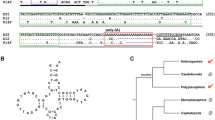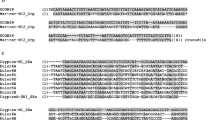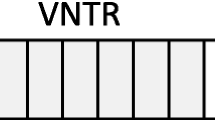Abstract
An analysis of the nuclear β-fibrinogen intron 7 locus from 30 taxa representing 12 placental orders of mammals reveals the enriched occurrences of short interspersed element (SINE) insertion events. Mammalian-wide interspersed repeats (MIRs) are present at orthologous sites of all examined species except those in the order Rodentia. The higher substitution rate in mouse and a rare MIR deletion from rat account for the absence of MIR in the rodents. A minimum of five lineage-specific SINE sequences are also found to have independently inserted into this intron in Carnivora, Artiodactyla and Lagomorpha. In the case of Carnivora, the unique amplification pattern of order-specific CAN SINE provides important evidence for the “pan-carnivore” hypothesis of this repeat element and reveals that the CAN SINE family may still be active today. Particularly interesting is the finding that all identified lineage-specific SINE elements show a strong tendency to insert within or in very close proximity to the preexisting MIRs for their efficient integrations, suggesting that the MIR element is a hot spot for successive insertions of other SINEs. The unexpected MIR excision as a result of a random deletion in the rat intron locus and the non-random site targeting detected by this study indicate that SINEs actually have a greater insertional flexibility and regional specificity than had previously been recognized. Implications for SINE sequence evolution upon and following integration, as well as the fascinating interactions between retroposons and the host genomes are discussed.


Similar content being viewed by others
References
Altschul SF, Madden TL, Schäffer AA, Zhang J, Zhang Z, Miller W, Lipman DJ (1997) Gapped BLAST and PSI-BLAST: a new generation of protein database search programs. Nucleic Acids Res 25: 3389–3402
Batzer MA, Deininger PL (2002) Alu repeats and human genomic diversity. Nature Reviews Genetics 3: 370–379
Betley JN, Frith MC, Graber JH, Choo S, Deshler JO (2002) A ubiquitous and conserved signal for RNA localization in chordates. Current Biology 12: 1756–1761
Cantrell MA, Filanoski BJ, Ingermann AR, Olsson K, DiLuglio N, Lister Z, Wichman HA (2001) An ancient retrovirus-like element contains hot spots for SINE insertion. Genetics 158: 769–777
Coltman DW, Wright JM (1994) Can SINEs: a family of tRNA-derived retroposons specific to the superfamily Canoidea. Nucleic Acids Research 22: 2726–2730
Das M, Chu LL, Ghahremani M, Abrams-Ogg T, Roy MS, Housman D, Pelletier J (1998) Characterization of an abundant short interspersed nuclear element (SINE) present in Canis familiaris. Mamm Genome 9: 64–69
Deininger PL (1989) SINEs: short interspersed repeated DNA elements in higher eukaryotes. In: Berg DE, Howe MM (Eds.), Mobile DNA. American Society of Microbiology, Washington DC, pp. 619–636
Deininger PL, Moran JV, Batzer MA, Kazazian Jr HH (2003) Mobile elements and mammalian genome evolution. Current Opinion in Genetics and Development 13: 651–658
Doolittle RF (1984) Fibrinogen and fibrin. Ann Rev Biochem 53: 195–229
Edwards MC, Gibbs RA (1992) A human dimorphism resulting from loss of an Alu. Genomics 14: 590–597
Felsenstein J (1985) Confidence limits on phylogenies: An approach using the bootstrap. Evolution 39: 783–791
Frengen E, Thomsen P, Kristensen T, Kran S, Miller R, Davies W (1991) Porcine SINEs: characterization and use in species-specific amplification. Genomics 10: 949–956
Gilbert N, Labuda D (1999) CORE-SINEs: eukaryotic short interspersed retroposing elements with common sequence motifs. Proc Natl Acad Sci USA 96: 2869–2874
Gilbert N, Labuda D (2000) Evolutionary inventions and continuity of CORE-SINEs in Mammals. J Mol Biol 298: 365–377
Hughes DC (2000) MIRs as agents of mammalian gene evolution. Trends in Genetics 16: 60–62
Jurka J, Zietkiewicz E, Labuda D (1995) Ubiquitous mammalian-wide interspersed repeats (MIRs) are molecular fossils from the Mesozoic era. Nucl Acids Res 23: 170–175
Jurka J, Klonowski P (1996) Integration of retroposable elements in mammals: selection of target sites. J Mol Evol 43: 685–689
Jurka J, Klonowski P, Trifnonv EN (1998) Mammalian retroposons integrate at kinkable DNA sites. J Biomol Struct Dyn 15: 717–721
Kidwell MG, Lisch DR (2001) Perspective: transposable elements, parasitic DNA, and genome evolution. Evolution 55: 1–24
Krane DE, Clark AG, Cheng JF, Hardison RC (1991) Subfamily relationships and clustering of rabbit C repeats. Mol Biol Evol 8: 1–30
Kumar S, Tamura K, Jakobsen IB, Nei M (2001) MEGA2: Molecular Evolutionary Genetics Analysis Software. Version 2.1. (Tempe, Arizona, USA: Arizona State University)
Maraia RJ (1995) The impact of short interspersed elements (SINEs) on the host genome. Springer-Verlag, New York
Minnick MF, Stillwell LC, Heinerman JM, Stiegler GL (1992) A highly repetitive DNA sequence possibly unique to canids. Gene 110: 235–238
Nikaido M, Matsuno F, Hamilton H, Brownell RL, Cao Y, Ding W, Zuoyan Z, Shedlock AW, Fordyce RE, Hasegawa M, Okada N (2001) Retroposon analysis of major cetacean lineages:The monophyly of toothed whales and the paraphyly of river dolphins. Proc Natl Acad Sci USA 98: 7384–7389
Okada N (1991) SINEs: short interspersed repeated elements of the eukaryotic genome. Trends Ecol Evol 6: 358–361
Pecon Slattery J, Murphy WJ, O’Brien SJ (2000) Patterns of diversity among SINE elements isolated from three Y-chromosome genes in carnivores. Mol Biol Evol 17: 825–829
Qin ZH, Schuller I, Richter G, Diamantstein T, Blankenstein T (1991) The interleukin- 6 gene locus seems to be a preferred target site for retrotransposons and retroviruses. Immunogenetics 33: 260–266
Rogers JH (1985) The origin and evolution of retroposons. Int Rev Cytol 93: 187–279
Salem AH, Ray DA, Xing JC, Callinan PA, Myers JS, Hedges DJ, Garber PK, Witherspoon DJ, Jorde LB, Batzer MA (2003) Alu elements and hominid phylogenetics. Proc Natl Acad Sci USA 100: 12787–12791
Sambrook E, Fritsch F, Maniatis T (1989) Molecular Clonging. Cold Spring Harbor Press, Cold Spring Harbor, NY
Schiefelbein JW, Furtek DB, Dooner HK, Nelson Jr OE (1988) Two mutations in a maize bronze-1 allele caused by transposable elements of the Ac-Ds family alter the quantity and quality of the gene product. Genetics 120: 767–777
Shedlock AM, Okada N (2000) SINE insertions: powerful tools for molecular systematics. BioEssays 22: 148–160
Slagel V, Flemington E, Traina-Dorge V, Bradshaw H, Deininger P (1987) Clustering and subfamily relationships of the Alu family in the human genome. Mol Biol Evol 4: 19–29
Smit AF, Riggs AD (1995) MIRs are classic, tRNA-derived SINEs that amplified before the mammalian radiation. Nucleic Acids Res 23: 98–102
Tatout C, Lavie L, Deragon JM (1998) Similar target site selection occurs in integration of plant and mammalian retroposons. J Mol Evol 47: 463–470
Thompson JD, Gibson TJ, Plewniak F, Jeanmougin F, Higgins DG. (1997) The clustalx windows interface: flexible strategies for multiple sequence alignment aided by quality analysis tools. Nucleic Acids Research 24: 4876–4882
Van der Vlugt HH, Lenstra JA (1995) SINE elements of carnivores. Mamm Genome 6: 49–51
Vassetzky NS, Kramerov DA (2002) CAN—a pan-carnivore SINE family. Mamm Genome 13: 50–57
Wang TH, Johnson N, Zou J, Bols N, Secombes CH (2004) Sequencing and expression of the second allele of the interleukin-1β1 gene in rainbow trout (Oncorhynchus mykiss): identification of a novel SINE in the third intron. Fish & Shellfish Immunology 16: 335–358
Wells D, Bains W (1991) Characterization of an unusual human histone H3.3 pseudogene. DNA Seq 2: 125–127
Wessler SR (1988) Phenotypic diversity mediated by the maize transposable elements Ac and Spm. Science 242: 399-405
Wichman HA, Van Den Bussche RA, Hamilton MJ, Baker RJ (1992) Transposable elements and the evolution of genome organization in mammals. Genetica 86: 287–293
Yu L, Zhang YP (2004) Phylogenetic studies of pantherine cats (Felidae) based on multiple genes, with novel application of nuclear β-Fibrinogen intron 7 to carnivores. Mol Phylogenet Evol 35: 483–495
Zehr SM, Nedbal MA, Flynn JJ (2001) Tempo and mode of evolution in an orthologous Can SINE. Mamm Genome 12: 38–44
Acknowledgments
This work was supported by the grants from National Natural Science Foundation of China (NSFC) and Chinese Academy of Science. Additionally, we thank Dr. Alfred Roca, Dr. Warren Johnson and Ms. Luo Shujin, National Cancer Institute, Laboratory of Genomic Diversity for improving the English of the manuscript.
Author information
Authors and Affiliations
Corresponding author
Rights and permissions
About this article
Cite this article
Yu, L., Zhang, Yp. Evolutionary implications of multiple SINE insertions in an intronic region from diverse mammals. Mamm Genome 16, 651–660 (2005). https://doi.org/10.1007/s00335-004-2456-3
Received:
Accepted:
Published:
Issue Date:
DOI: https://doi.org/10.1007/s00335-004-2456-3




